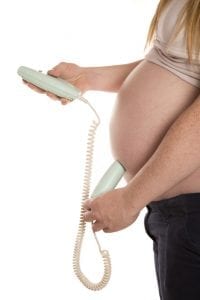
There is nothing like hearing your unborn baby’s heartbeat for the first time.
Many pregnant mothers yearn to hear this sound long after they leave the doctors office. This may be to help easy their worry for the baby, to share with others, or to just share a bonding moment with their baby.
Much like an ultrasound, an at-home doppler or fetoscope device provides concrete proof that your baby really is growing inside of you! However, it is important to consider the pros, cons, and healthy concerns that comes with the use of these at-home monitors before using them yourself.
At-Home Dopplers and Fetoscope Devices
These at home monitors are used by pregnant mamas to listen to baby’s heartbeat. Most at-home devices are not able to pick up the sound of your baby’s heartbeat until around 10 to 14 weeks.
There are two ways to hear your baby’s heartbeat at home, one is a doppler and the other a fetoscope.
A doppler, also known as doptones or doppler probes, is a handheld device that uses high-frequency sound waves to hear your baby’s heartbeat. These sound waves pass through your tissue and into the baby, where they then bounce back after they experience movement. This movement is then translated back into sound and amplified through the doppler.
A fetoscope looks very similar to that of a stethoscope. A fetoscope works by amplifying the sound within your body, so that you are able to hear the baby’s heartbeat.
The Discussion on At- Home Devices
While most midwives and doctors use a doppler or fetoscope at appointments, there are many that argue that they are not safe for at home use. It is important to consider the benefits and possible health concerns that may arise.
Benefits of these Devices
For many pregnant women, stress and worry over your baby is a common thing. It is common for women to be concerned for their child’s safety and if their baby is still growing properly inside of them. Stress is not healthy for mom or baby. An at-home doppler or fetoscope can help to ease your mind from time to time and reassure you that your baby is in fact there safe inside of your belly.
It can allow mothers some comfort and reassurance, a peace of mind, when emotions and anxiety run high. Many woman have reported using the doppler’s as a part of their nightly routine to help relax before bed.
These devices can also allow for the father and other family members to feel more involved and close to the baby. While mom may always feel a close connection to the baby, because they are carrying the child, it may be hard for others to feel involved. By using these at-home devices it allows others to hear the baby’s heartbeat and can work to develop a stronger bond and beautiful memories.
Some moms also may use it to show their other children what it means when mom is pregnant.
Possible Health Concerns to Consider
 When a mother thinks something is wrong, she may use her at-home device and decide that things are alright once she finds the heartbeat on her own. Kicks Count, a leading stillbirth charity, claims that these devices can give pregnant women a false sense of security during these times. If a woman thinks that everything is alright once she has found the heartbeat, she may not then go out and seek medical assistance that might be necessary.
When a mother thinks something is wrong, she may use her at-home device and decide that things are alright once she finds the heartbeat on her own. Kicks Count, a leading stillbirth charity, claims that these devices can give pregnant women a false sense of security during these times. If a woman thinks that everything is alright once she has found the heartbeat, she may not then go out and seek medical assistance that might be necessary.
The U.S. Food and Drug Administration (FDA) warn pregnant women against handheld dopplers and claim that, “They should only be used when there’s a medical need or only by, or under the supervision of, a healthcare professional.” Although you can use these devices at home, they go on to say that it is not as easy as it looks to use properly. These devices are actually prescription medical devices and fit within the same category as that of an ultrasound machine.
A problem with these high-frequency waves, used in at-home dopplers, bouncing through your body is that anything that moves inside of you is also translated into sound. So this can make it confusing to determine if you are correctly finding your baby’s heartbeat or if you have instead found the blood flowing in your arteries or air moving in your intestines. It takes a lot of training and practice to properly distinguish a baby’s heartbeat from other sounds that you may find. Without the proper training it will also make it unlikely to be able to recognize the changes in rate or rhythm to indicate a problem with baby.
While there are not ultrasound waves being emitted through fetoscope devices, the same issue of lack of training and being able to decipher proper sounds remain.
It is possible that these devices could cause more stress if you are unable to locate the heartbeat during use. Without proper training it can be hard to find the baby’s location with these monitors. The baby may be in the wrong position or is not big enough yet to hear and this may sometimes cause mothers to worry about their baby’s well being. It is important for pregnant women to try to avoid stress as these hormones can have harmful effects on your growing baby.
While there have not been any human studies of birth defects associated with ultrasound and doppler use, animal studies have revealed that ultrasound waves can heat the brain, and result in brain hemorrhages, as well as damaged intestines after exposure.
The long-term effects of repeatedly exposing a baby to these ultrasound waves from these devices are unknown.
Overall
It is important to do your research and decide what is best for you and your baby.
If you do decide to use an at-home doppler or fetoscope device during your pregnancy, make sure to inform your doctor and to not fully rely on the accuracy of your device, as it is easy to misinterpret without proper training.
As a general rule, brief periods of ultrasound exposure are unlikely to be problematic, however, daily exposure could be problematic.
You can also talk to your doctor about other ways to help keep tabs on how your baby is doing. There are ways to track your baby’s movements, once you can feel them regularly to help reassure you that your baby is growing safely inside of you.


